Have you ever found yourself puzzled over which rice to choose – Basmati or Jasmine?
At first glance, they look nearly identical, both being long-grain varieties. Each one tempts with a promise of an Asian culinary adventure, but the question remains – which one should you pick?

Interestingly, while they may appear similar, each has its unique aroma – Basmati carries a hint of nuttiness, while Jasmine has a subtle floral scent.
This brings in an extra layer to the decision-making procedure. Curious? Stick around as we delve deeper into the world of these two rice varieties.
In this article:
What is Basmati Rice?
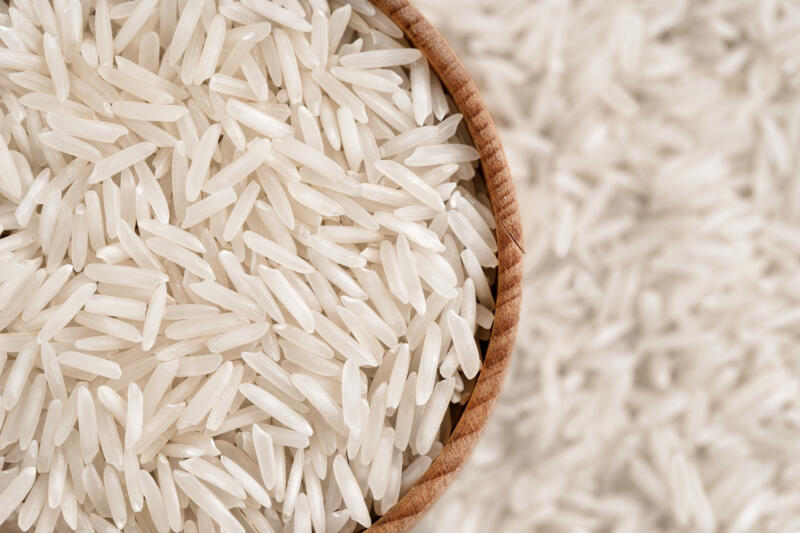
Basmati rice, a staple in South Asia and Middle Eastern cuisines, is a unique type of long-grain rice known for its distinct characteristics.
Hailing from the Indian subcontinent, the term “Basmati” means “fragrant” or “aromatic” in Sanskrit, aptly describing the nature of this rice type.
A standout characteristic of Basmati rice is its distinct nutty flavor. This special taste distinguishes it from other rice types, earning it the favor of numerous food lovers.
When cooked, it releases a fragrant aroma that is both enticing and comforting, adding an extra layer of sensory delight to your dining experience.
The long-grain structure of Basmati rice is another defining characteristic.
Each grain remains separate when cooked, resulting in a fluffy and light texture that complements a wide range of dishes, from biryanis and pilafs to curries and side dishes.
Nutritional Benefits of Basmati
In terms of nutritional benefits, Basmati rice is a powerhouse.
It’s free from gluten, making it an ideal option for those on a gluten-free diet.
Moreover, basmati is rich in fiber and vitamins, contributing to a balanced diet.
Notably, this rice type has a low glycemic index, which means it’s digested slowly, helping to maintain steady blood sugar levels!
What is Jasmine Rice?
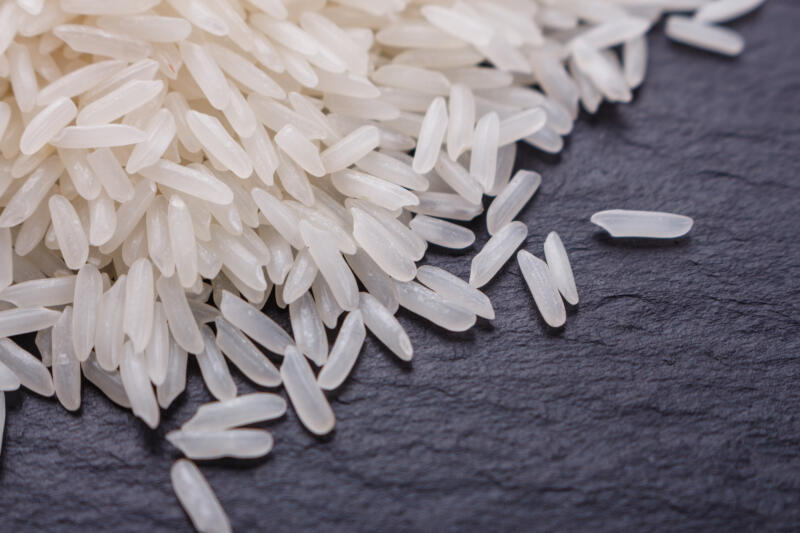
Jasmine rice, a renowned long-grain rice type, originates from the lush landscapes of Thailand.
Named after the sweet-smelling jasmine flower, this rice is renowned for its beautiful, white color that resembles the jasmine flower’s delicate petals.
The first thing you’ll notice when cooking Jasmine Rice is its floral aroma. This scent is reminiscent of pandan, a tropical plant commonly found in Southeast Asia.
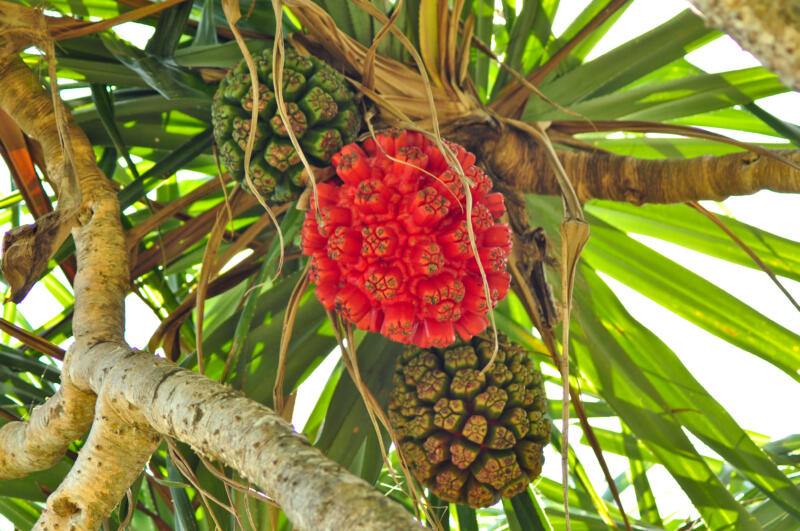
The aroma is not only pleasing but also enhances the overall taste of the dishes it’s used in.
Jasmine rice is characterized by its soft and slightly sticky texture when cooked.
This adhesive quality makes it perfect for recipes where the rice needs to bind together.
It’s also commonly used as a base for desserts, adding a subtly sweet flavor and creamy texture.
In Southeast Asian cuisine, Jasmine Rice is a staple.
It’s often served alongside spicy curries, stir-fries, and grilled meats, providing a balance to the robust flavors of these dishes.
Nutritional Benefits of Jasmine Rice
Jasmine Rice is nutritionally rich in carbohydrates and fiber, offering a swift energy boost and promoting digestion.
Yet, it has a higher glycemic index than Basmati Rice, leading to a quicker digestion and a rapid increase in blood sugar.
On the other hand, Basmati Rice, like all natural rice varieties, is free from gluten. This makes it suitable for individuals with celiac disease or gluten intolerance.
Nonetheless, it’s crucial to understand that even though the rice is gluten-free, it might get tainted with gluten during its processing or cooking if it interacts with gluten-containing ingredients.
Nutrition Comparison
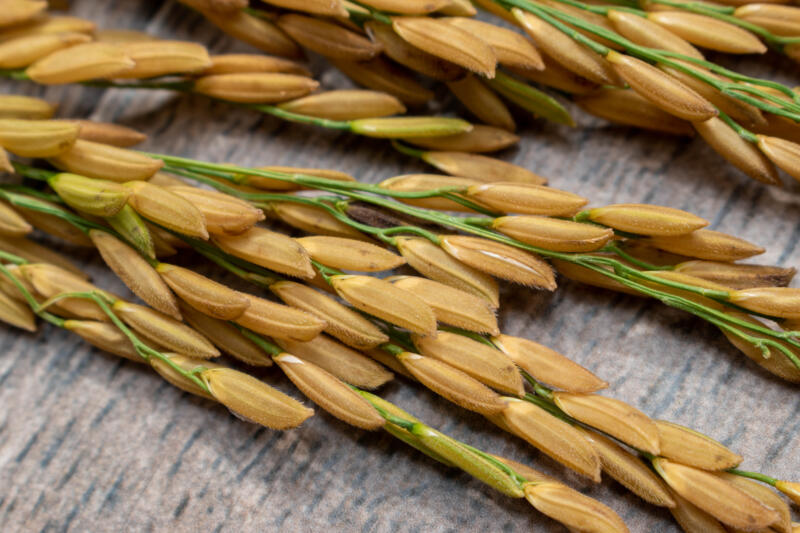
Let’s delve into the nutritional comparison of these two popular rice varieties, focusing on their calorie content, carbohydrate levels, and protein content.
1. Calories
The calorie content in rice can vary depending on the type of rice and how it’s cooked.
On average, a cup of cooked Basmati Rice contains about 210 calories.
On the other hand, the same serving of Jasmine Rice has slightly more, around 238 calories.
The difference in calorie content can be attributed to the slightly higher carbohydrate content in Jasmine Rice.
It’s important to note that these values can vary based on cooking methods and any additional ingredients used.
2. Carbohydrates
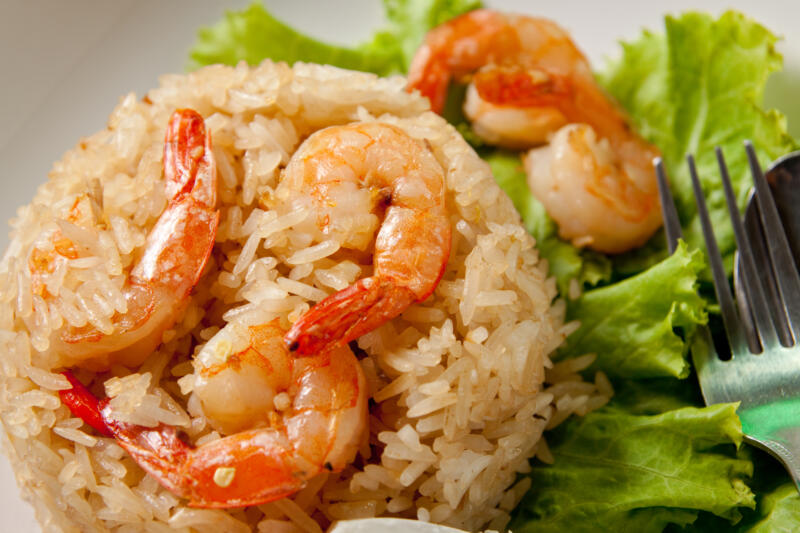
Carbohydrates are a primary source of energy for our bodies, and both Basmati and Jasmine Rice are good sources of this macronutrient.
A cup of cooked Basmati Rice contains approximately 45 grams of carbohydrates, while Jasmine Rice contains slightly more, around 50 grams per serving.
This higher carbohydrate content contributes to Jasmine Rice’s higher calorie content and can provide a quick source of energy.
3. Protein Content
Protein is a crucial nutrient that supports various bodily functions, including muscle growth and repair.
When it comes to protein content, both Basmati and Jasmine Rice offer a modest amount.
A cup of cooked Basmati Rice provides about 5 grams of protein, while the same serving of Jasmine Rice offers slightly less, around 4 grams.
While rice isn’t a high-protein food, it can contribute to your daily protein intake, especially when paired with other protein-rich foods.
4. Fat Content
When it comes to fat content, both Basmati and Jasmine Rice are low-fat foods, making them a healthy addition to your diet.
However, Basmati Rice has a slight edge over Jasmine Rice, with a lower fat content.
A cup of cooked Basmati Rice contains about 0.5 grams of fat, while the same serving of Jasmine Rice contains around 1 gram.
This difference, although small, can be significant for individuals monitoring their fat intake.
5. Fiber Content
Fiber plays a crucial role in promoting healthy digestion and overall health.
Both Basmati and Jasmine Rice contribute to your daily fiber intake, but the amounts differ. A cup of cooked Basmati Rice provides about 1.8 grams of fiber, while Jasmine Rice offers slightly less, around 1 gram.
Including fiber-rich ingredients in your rice dishes can further enhance their nutritional value and health benefits.
6. Vitamins & Minerals Found in Both Types of Rice
Basmati and Jasmine Rice are not just sources of carbohydrates; they also provide essential vitamins and minerals. These nutrients support various bodily functions and contribute to overall well-being.
Both types of rice have vitamin B1 (thiamine), essential for energy generation and nerve activity.
They also offer minerals such as magnesium, phosphorus, and zinc, which are fundamental for bone strength, energy processing, and immune system performance, respectively.
7. Blood Sugar Levels After Eating Basmati or Jasmine Rice
The type of rice you choose can impact your blood sugar levels.
Whole grains, such as brown Basmati and Jasmine, are considered better options for managing blood sugar levels compared to their white counterparts.
This is because whole grains contain all parts of the grain — the bran, germ, and endosperm.
Foods made from these grains are rich in fiber and magnesium, both of which can help lower blood sugar levels and reduce the risk of type 2 diabetes.
The glycemic index, a measure of how quickly a food raises blood sugar levels, is another important factor to consider.
Brown Basmati and Jasmine Rice have a lower glycemic index compared to white rice, making them a better choice for individuals managing their blood sugar levels.
Cooking Methods for Basmati and Jasmine Rice
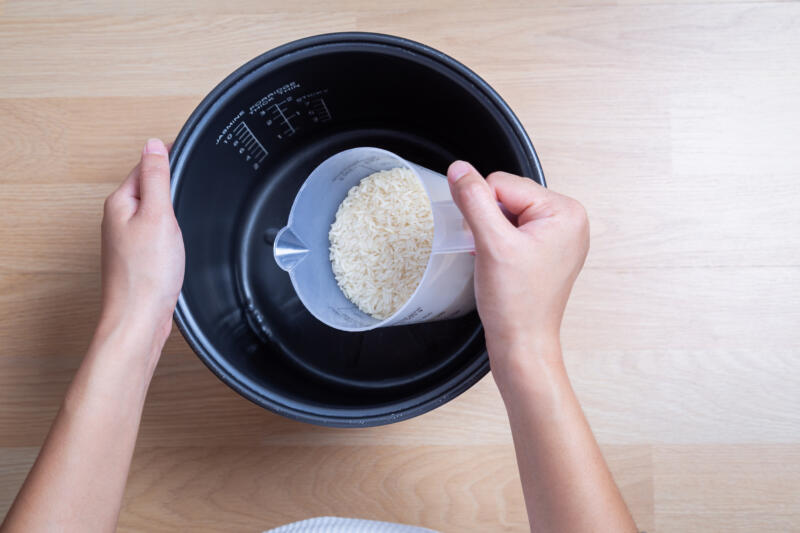
Cooking Basmati and Jasmine Rice involves more than just boiling water. For both types of rice, the water-to-rice ratio and cooking time are crucial factors that can affect the final texture and flavor.
Basmati Cooking
Basmati rice traditionally requires soaking for about 30 minutes before cooking. This helps the grains elongate to their maximum length and ensures a fluffy texture.
It’s advisable to wash the rice with cold water before soaking.
Washing the rice about three times helps to remove any excess starch, making it easier for our bodies to digest and preventing the rice from becoming overly sticky.
It also helps to remove any impurities that the rice may have picked up from the processing facility.
Once the rice is thoroughly rinsed and soaked, it’s time to cook.
If you’re using a rice cooker, simply add the rice and water in a 1.5:1 ratio, then sit back and let the cooker take the stage for its solo performance.
If you’re using a pan, add the rice and water, bring it to a boil, then reduce the heat to low, cover the pan, and let it simmer for about 15-20 minutes.
Once the rice has finished cooking, it’s important to gently stir it with a silicone spatula or rice paddle.
This action aids in separating the individual grains and allows any remaining steam to escape, ensuring that the rice doesn’t turn out overly dense or stick together in clumps.
Upon cooking, Basmati rice transforms into fluffy, distinct grains that carry a pleasing aroma and a distinctive nutty taste.
Jasmine Rice Cooking
Preparing Jasmine rice is simple, whether you opt for a rice cooker or a basic pot.
Contrary to Basmati, Jasmine rice doesn’t require soaking. However, it’s a good practice to rinse the rice before cooking.
Washing the rice about three times in cold water helps to remove any excess starch, which can make the rice overly sticky.
Additionally, it helps to eliminate any potential contaminants that the rice might have acquired during processing.
Once the rice is thoroughly rinsed, it’s time to cook.
If you’re using a rice cooker, simply add the rice and water in a 1:1 ratio, then let the cooker do its job.
If you’re using a pan, add the rice and water, bring it to a boil, then reduce the heat to low, cover the pan, and let it simmer for about 15 minutes.
After the rice is cooked, it’s essential to fluff it gently with a silicone spatula or a silicone rice paddle. These tools are gentle on your cookware and won’t scratch the surface.
This step ensures the grains remain distinct and allows for the release of extra steam, preventing the rice from becoming too compact or clumped together.
When Jasmine rice is prepared the right way, the grains exhibit a subtle stickiness, coupled with a soft consistency and a delightful floral fragrance.
Flavor & Texture Comparison
When it comes to the culinary world of rice, the flavor and texture can dramatically shape the dining experience.
The choice between Basmati and Jasmine rice hinges on the culinary creation you have in mind.
For dishes where you desire the rice to remain separate and absorb flavors, Basmati is your champion.
However, if your recipe calls for a slightly sticky texture, Jasmine rice takes the crown.
Now, let’s explore the unique attributes of these long-grain varieties, Basmati and Jasmine rice, and their distinct flavor profiles.
Even though both are long-grain types, they have distinct features that cater to different culinary dishes.
Basmati Rice Texture and Flavor
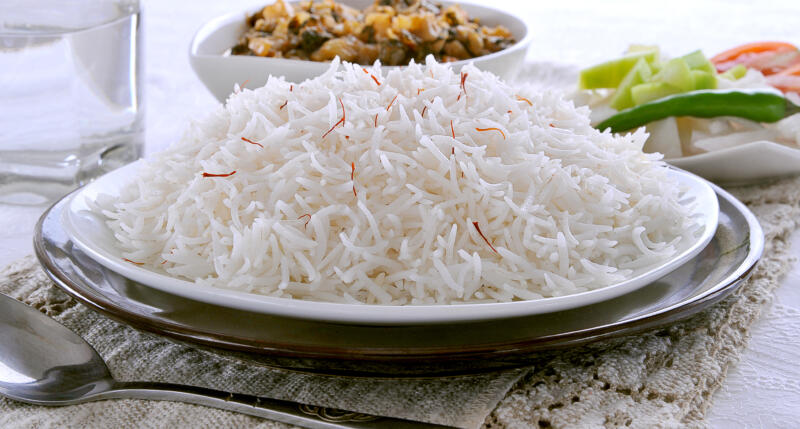
Basmati rice, renowned for its signature fragrance and a mild nutty taste, is a cornerstone of Indian and Middle Eastern meals.
When cooked, the slender grains of Basmati expand even further. The grains remain separate, resulting in a fluffy texture that’s perfect for pilafs and biryanis where you want the rice to shine on its own.
It’s also a great accompaniment to curries and stews, as it can soak up the flavors without becoming mushy.
Jasmine Rice Flavor and Texture
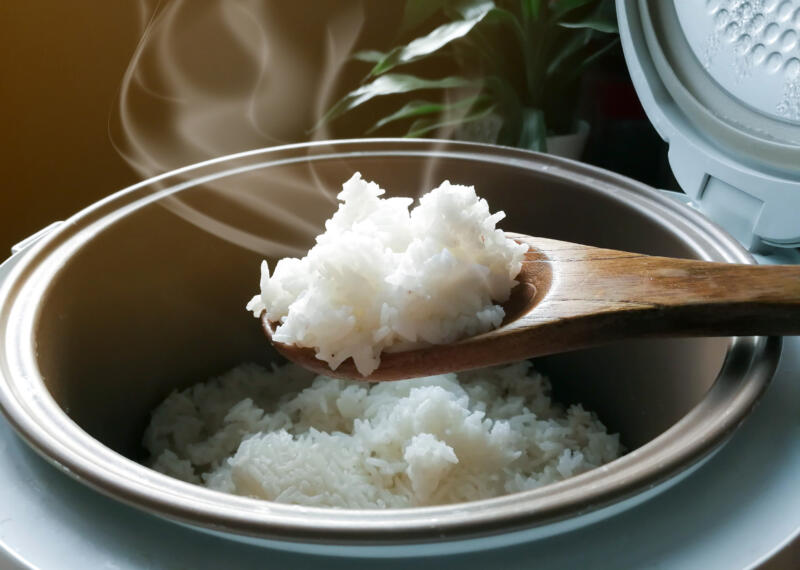
On the flip side, Jasmine rice, with its distinct floral scent and somewhat sticky consistency when cooked, is a favorite in Southeast Asian meals. This rice has slightly shorter and thicker grains compared to Basmati.
It’s the go-to rice for dishes like Thai fried rice or Vietnamese clay pot rice where the slightly sticky texture helps to hold the dish together.
It’s also the preferred choice for dishes with a lot of sauce, as the grains can cling together and make it easier to eat with chopsticks.
Common Dishes with Basmati and Jasmine Rice
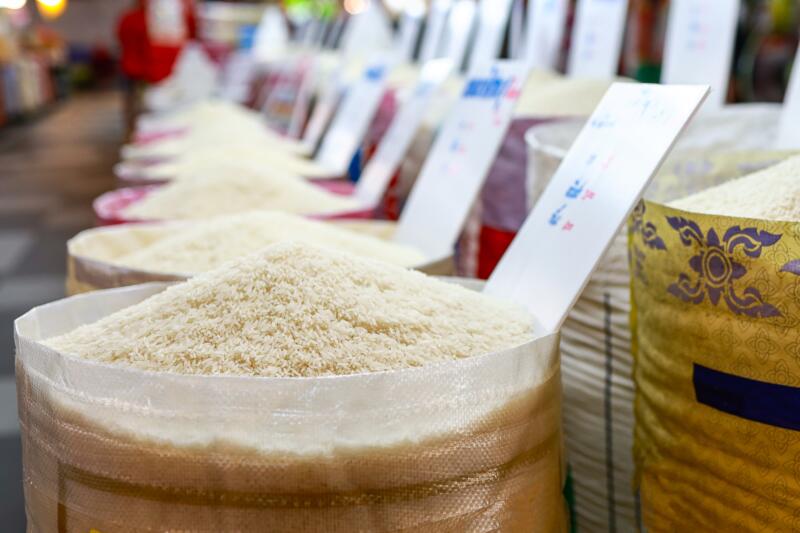
Traveling through South and Southeast Asia, one will quickly discover the starring role that both Basmati and Jasmine rice play in the region’s cuisine.
These versatile grains make their way into an array of dishes, showcasing their adaptability and unique characteristics.
From the aromatic curries of Thailand, where Jasmine rice provides a perfect, slightly sticky companion, to the flavorful biryanis of India, where Basmati’s long, fragrant grains truly shine, these rices are a staple.
Here are some common dishes for each type of rice:
Top Common Dishes based on Basmati Rice
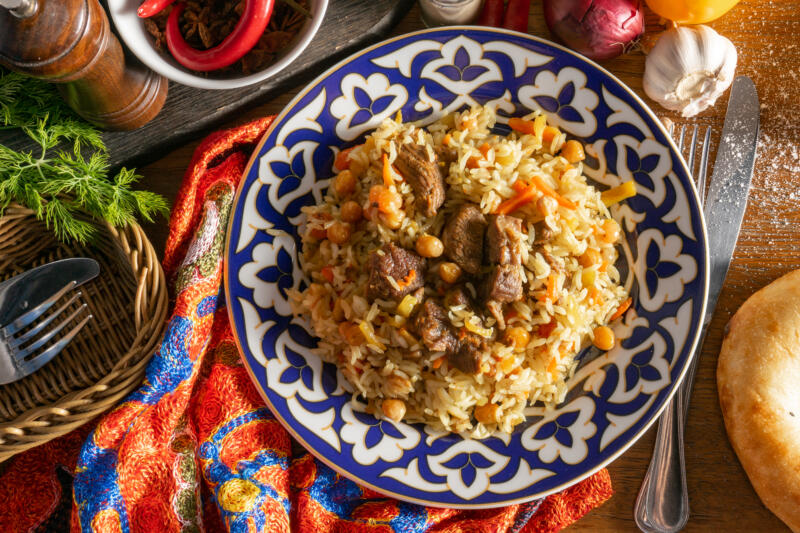
- Biryani: A flavorful Indian dish made with aromatic spices, meat (like chicken, mutton, or fish), and Basmati Rice.
- Pilaf: A fragrant rice dish cooked in a seasoned broth, often with vegetables or meat.
- Jeera Rice: A straightforward but flavorful Indian preparation where Basmati Rice is paired with cumin seeds.
- Kheer: A traditional Indian rice pudding crafted from Basmati Rice, milk, and sugar, and enhanced with cardamom, raisins, saffron, and nuts.
- Tahdig: A Persian dish where Basmati Rice is cooked to create a crispy bottom layer.
- Iraqi dill rice: This popular rice dish is made with fava beans and dill. It’s packed with flavor and can be prepared in a single pot. You have the option to include meat or keep it as a vegetarian dish.
- Chicken machboos: A harmonious blend of onions, garlic, dry lime, cinnamon, cardamom, and bay leaves spices up this Saudi Arabian rice dish. Accompanied by crispy chicken, it’s garnished with toasted pine nuts and raisins.
- Middle Eastern stuffed vegetables: This authentic Iraqi Dolma recipe involves stuffing vegetables with a mixture of rice and meat.
Common Dishes based on Jasmine Rice
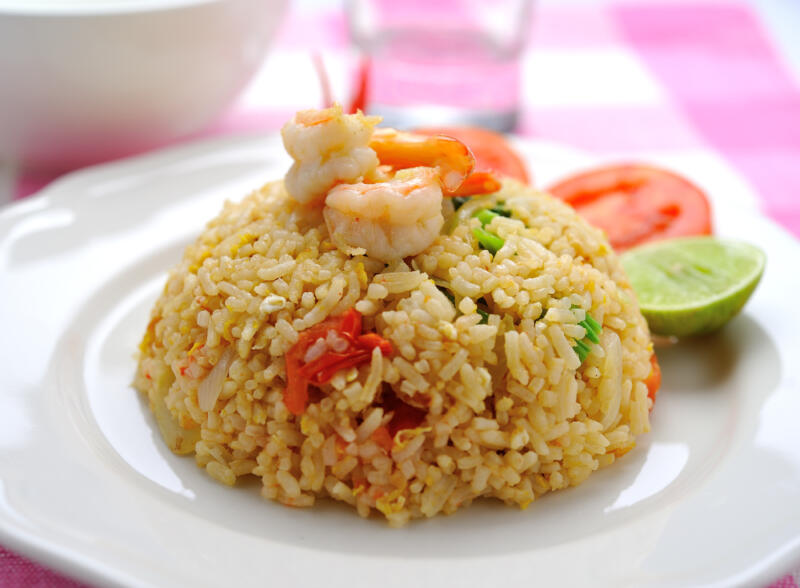
- Thai Fried Rice: A popular Thai dish made with Jasmine Rice, vegetables, protein (like tofu, shrimp, or chicken), and flavored with soy sauce and garlic.
- Khao Pad: A Thai rendition of fried rice, typically served with an assortment of sides.
- Mango Sticky Rice: A classic Thai dessert crafted from sticky Jasmine Rice, paired with fresh mango slices and drizzled with sweet coconut milk.
- Hainanese Chicken Rice: A cherished Singaporean delicacy in which Jasmine Rice is simmered in chicken stock and served with tender poached chicken.
- Khao Soi: A creamy and spicy noodle soup from Northern Thailand, often served over Jasmine Rice.
- Cơm Cháy Kho Quẹt: This is a popular Vietnamese dish where Jasmine rice plays a starring role. It’s essentially crispy rice with a thick, savory sauce made from braised pork, shrimp, and a variety of spices.
- Cơm tấm: A Vietnamese dish made with broken Jasmine Rice. It’s traditionally served with grilled pork (either ribs or shredded) and a typical Vietnamese fish sauce dressing. The dish is garnished with green onions and pickled vegetables.
Closing Thoughts
We’ve journeyed through the fascinating world of Basmati and Jasmine Rice, exploring their unique characteristics, nutritional values, and the dishes they best complement.
We’ve seen how these two types of rice, while similar in some ways, each bring their unique flavors and textures to the table.
Whether it’s the fragrant aroma of Basmati Rice enhancing an Indian biryani or the sticky texture of Jasmine Rice making a Thai curry even more enjoyable, these grains have a lot to offer.
I encourage you to experiment with these techniques and dishes in your own kitchen.
Who knows? You might just discover your new favorite rice dish!
As always, if you have any questions or comments, feel free to share.